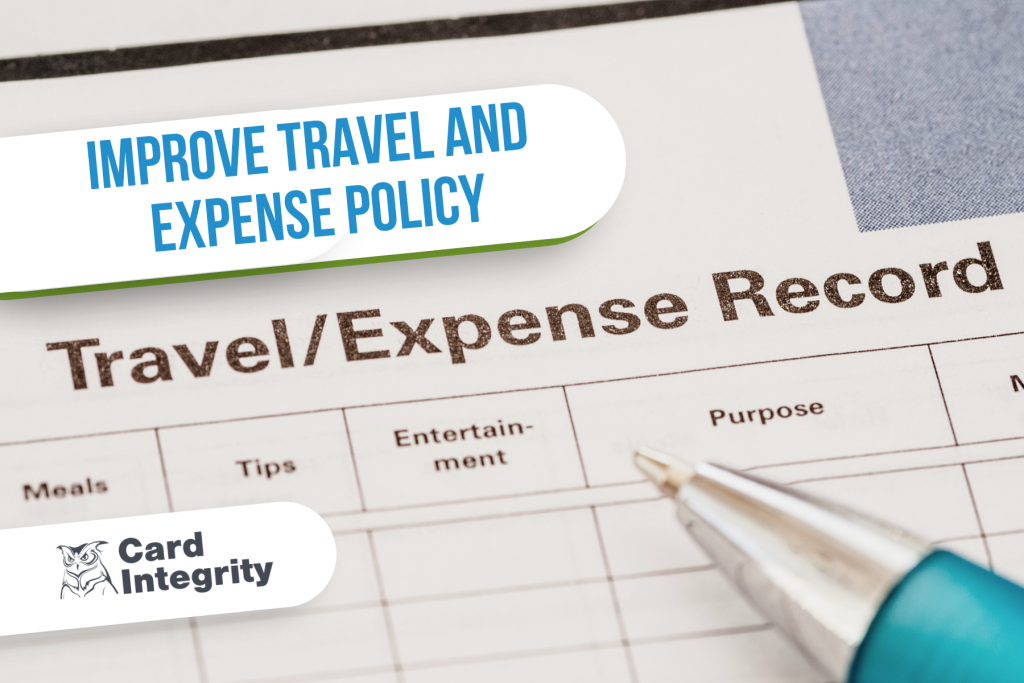Travel and expense, or travel and entertainment spending also known as T&E are essential for organizations participating in business travel. That said, it’s also very easy for an employee to get carried away with purchases on a trip or for compliance issues to surface. This is why a strong T&E policy is necessary.
As business travel starts to ramp up over the next few months, it’s important to tune up your T&E policy to set clear expectations. Here are some key areas to focus on including some strategies to improve your T&E policy for compliance.
Table of contents
- The Purpose of a Strong T&E Policy For Compliance
- Use Categories for Spending Guidelines
- Include a Comprehensive Booking Process
- Make It Easy to Read
- Discuss Tax Implications
- Communicate a Plan for Reimbursements
- Automate a Process for Maintenance
- Check Compliance off Your To-Do List for T&E Expenses
- Find More Articles on BusinessTravel & Policy
The Purpose of a Strong T&E Policy For Compliance
A T&E policy lays out how an employee should use their Corporate Credit Card or T&E Card for business travel. Without a clear and comprehensive policy, it will be harder to communicate about charges. Additionally, it will be difficult to pinpoint where overspending might have occurred.
Also, the lack of a strong policy opens the door to fraud and dishonest reimbursement requests which wastes money and resources. Business trips are just that. They aren’t vacations and there are budgets that apply along with certain processes and approved suppliers.
A strong T&E policy will help your organization remain compliant, uncover cost savings, and continue to focus on the main intent for business travel. Even if you have a good policy in place, there’s always room for improvement. Make sure you’re implementing the following tactics to deliver a clear and compliant T&E policy that everyone can refer to.
Use Categories for Spending Guidelines
Travel is a big category in itself. Be sure to break down different types of expenses employees may have when going on a business trip. That way, they’ll feel like they have enough direction.
Use categories such as:
- Flights
- Rental car
- Hotel accommodations
- Dining
- Supplies
- Ground transportation
- Entertainment
Be clear about spend limits in each category along with which suppliers or partners you have contracts with and are fine to use.
Include a Comprehensive Booking Process
Everyone books travel differently. So if there is a specific process you’d like employees to follow, be sure to outline it clearly in the T&E policy. Do you expect employees to use a certain website or airline when booking accommodations? Is there a desired timeframe for booking corporate travel such as getting everything confirmed at least 14 days in advance?
It’s important to keep the process concise and to the point while using simple language that the reader will understand. You can also include screenshots, examples, and other visuals to clarify what’s expected during the booking process.
Make It Easy to Read
A T&E policy for compliance that effectively reduces risk is easy to read and digest. In addition to using simple and straightforward language, commit to eliminating any fluff from the policy.
Review your existing policy and see if there are any sentences or details that don’t really serve a purpose. Remove unnecessary language and consider replacing it with actionable terms and clear guidelines that are easy to comprehend.
Also, adding a table of contents to outline the policy beforehand is a good idea. Including bullet points, charts, tables, and graphics when applicable will also break up the text and encourage employees to actually read through the policy in its entirety.
Discuss Tax Implications
According to the IRS, most business travel expenses are tax-deductible so long as the trip is for a business purpose and you’re sleeping and resting away from your home city. However, organizations must be ready to show that the travel or event benefits the business in some way. There are standard deductions for meals and other expenses but it’s crucial to require employees to submit receipts.
Make sure the recordkeeping requirements in your T&E policy comply with federal, state, and industry rules and regulations to maintain compliance.
Communicate a Plan for Reimbursements
Dealing with reimbursements and reviewing travel spend can be challenging. When employees return from a business trip, they are often inundated with emails, follow-ups, and other work-related tasks as they try to get back into a routine.
A T&E policy can be helpful in providing guidance on submitting requests for reimbursement. That way, these things don’t get lost in the shuffle. Start collecting feedback from employees and expense reports to see if any common trends occur. Are there expenses that should be included in the policy but aren’t?
Do the reimbursement requests seem reasonable and within policy protocols? Are requests being submitted on time and with the proper supporting documentation? Have you included non-reimbursable items in the policy?
Use the T&E policy to clearly communicate how reimbursement requests should be sent and how they will be handled. Set a deadline for employees to submit everything and outline when they should expect to receive a reimbursement.
Automate a Process for Maintenance
A T&E policy for compliance often includes two main parts: the policy itself and the method to maintain and monitor expenses to confirm the policy is being followed. You can have the best T&E policy ever, but this is only half the battle. A strong T&E policy doesn’t ensure that expense fraud or card misuse won’t occur and cause compliance issues.
Even if you clarify travel partners in the policy, there’s still a chance that these partners may not get utilized. This means the organization will miss out on the discounts and cost savings.
It’s crucial to follow up on expense review methods to call out red flags and keep employees accountable for following the T&E policy. Partnering up with a third-party expense review company like Card Integrity can help increase visibility, automate existing processes, and help you save time and money.
Check Compliance off Your To-Do List for T&E Expenses
Business travel helps build relationships, foster connections, and supports the organization’s bottom line. A clear and effective T&E policy can help both employees and finance managers experience a smoother experience on the financial side of things.
When it comes to actually monitoring travel and entertainment expenses and validating card charges and receipts, Card Integrity is fully equipped to help you check compliance off your already full to-do list.
Card Integrity monitors 100% of card purchases including travel-related costs. Our flagship service, DataWISE, provide monthly reports that can be customized to focus on compliance with your specific T&E policy.
Save time by increasing visibility with our reports and uncovering important trends and red flags without having to contribute hours of manual work. At Card Integrity, we understand the growing challenges that come with monitoring expenses for compliance and sorting through a constantly growing amount of card data.
If you’re ready to upgrade T&E policies while simplifying the review process, learn more about our services here, or fill out this brief form to request a free demonstration.
For More Tips, Download the Complete T&E Best Practices eGuide
Card Integrity’s T&E card expense review best practices eGuide will provide your organization with a clear and detailed outline of best practices that can be implemented into your program today.



